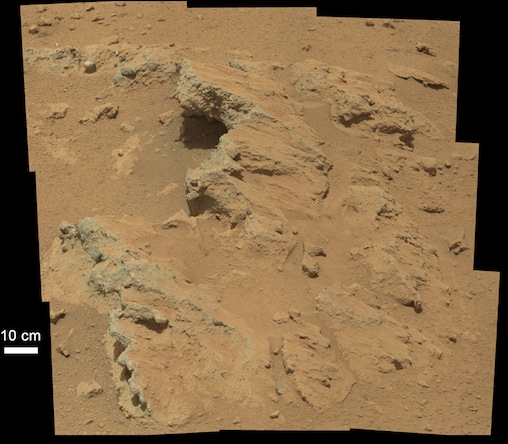Less than two months into its mission, NASA scientists say the Curiosity rover has found evidence of a "vigorous" thousand-year water flow on the surface of Mars.
This is exciting news for NASA scientists who sent the nuclear-powered, SUV-sized super rover to Mars with the hopes that it would find evidence of whether Mars was ever capable of supporting life.
On Thursday, scientists said they have found new evidence that water, one of the keys to sustaining life, once raced across an area not far from where Curiosity landed in August.
The evidence came in the form of an outcropping of rocks that appears to have been heaved up and covered with streambed gravel. The rover drove by the outcropping, which had earlier been spotted by one of NASA's Mars orbiters.
"We found interesting outcrops," said John Grotzinger, a project scientist with NASA's Jet Propulsion Laboratory and a geology professor at the California Institute of Technology. "It looks like someone came along with a jackhammer and lifted up a sidewalk... This is a rock that was formed in the presence of water... a vigorous flow in the surface of Mars. We are really excited about this because this is the reason we came to this site."
Scientists said they believe the water moved at about three feet per second, at a depth between ankle and hip deep. While they could not say when the water flow started or stopped, they estimated that it lasted more than 1,000 years.
This isn't the first time that NASA has reported discovering evidence of water on Mars.
Just over a year ago, NASA announced that the Mars Reconnaissance Orbiter had taken images showing evidence of past water flows on the Martian surface. NASA scientist said the planet might hold frozen water just beneath its surface.
William Dietrich, Curiosity's science co-investigator, called this latest discovery a turning point.
"This is the first time we're actually seeing water-transported gravel on Mars," he said. "This is a transition from speculation about the size of streambed material to direct observation of it."
Dietrich noted that scientists now have visual evidence of particle collisions during the transportation of water, a finding that shows there was a "vigorous" water flow and not a small amount of water seepage.
"Now that we're down on the ground with Curiosity we can see the textural evidence, the individual pebbles, the rounding that gives us a sense of that," he said. "It wasn't a single burst of water that ran down the canyon all in a day. There are too many things that point away from that. How long would it take? This is opening the door to answering that question."
Grotzinger said the discovery signifies the real beginning of the rover's science mission.
Now that scientists have proof that water once flowed across Mars, they can begin to look for signs of other elements, such as carbon, that are also needed to support life.
"Now we look at more rocks," said Grotzinger. "We get more context. We need to recreate the environment with even greater detail, with an understanding of the chemistry going on at that time, to understand if this was an area where an organism once lived. Was this an inhabitable environment? That is still to be determined."

NASA scientists said the Curiosity rover found evidence of an ancient flowing stream in this rock outcropping.





